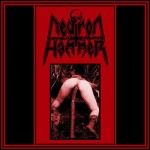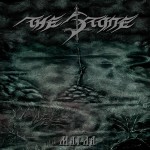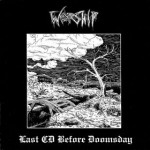Hellfires were set loose in Helsinki, Finland last weekend by a horde of black metal maniacs from all over the Earth. Profanation, an intangible feeling of myth, alignment of spirits, pervaded the atmosphere. Let me remind you that while the gig situation concerning underground black and death metal in Finland is rich and fertile, every so-called cult band appearing on stage is no longer going to change anyone’s life to something more mysterious and powerful. Maybe the younger audience sees the matter differently, but I believe they are becoming jaded also. This weekend was something different however. The main event was the 2-day Black Flames of Blasphemy fest, on 23rd and 24th, the Friday night featuring Taake and Horna, among others, but I wasn’t attending, on one hand because of a lack of interest regarding the bands, on the other because I could use one spare night between the “pre-party” on 22th (aptly called “Unholy Night to Remember”) and the Saturday explosion featuring bands of the caliber of Blasphemy and Revenge from Canada.
The dark side of Finland
So, it all started on a rainy and windy Thursday night, in a small Helsinki pub called Darkside which I had only visited once before, when it was empty. No-one was expecting a large crowd because normal people would have jobs and studies to attend to, but the place was crowded and intense. Demonos of Barathrum, the drunken bastard, was shouting at the doorman and people were consuming beer like it was the eve of ragnarók. In that one room of a few hundred cubic meters had been compressed all the dreams and neuroses of Finnish black metal since its very beginning. Even Pete Helmkamp came around to see for himself what the fuck was going on. Ofdoom, a Blasphemy clone from Hamina whose members are barely 18 years old, played a reasonably aggressive set of uncannily familiar sounding songs. I am thankful that at least the cover song choice was “Christ’s Death” by Sarcofago instead of something from the war metal scene. Many of the old school maniacs I met applauded the energy and sincerity these young guys brought to the evening. However, I was more thrilled by the Goatmoon set that saw the audience become a rioting mass of fists and headbanging. The garage punks of Finnish black metal, Goatmoon unleashed a set of familiar songs from their albums mostly resembling a triumphantly melodic cross of Dimmu Borgir demos and Absurd, not to mention an enormously provocative cover from Finnish RAC band Mistreat.
But the real reason why everybody was there that night, the crux of all the anticipation and nervous violence was the return of the infamous Azazel on stage, an early Finnish black metal coven lost to annals of history but fondly remembered by everyone who breathed the air of 90′s Finland, when worship of darkness was still pure and cold… clad in spikes. Stories about Azazel and their infamous frontman Lord Satanachia are equivalent to an inverted saga, one of madness and devotion. For a decade the band was forgotten until suddenly it seemed to have reformed in alliance with some members from young occult metal band Charnel Winds. It all seemed unbelievable and to see it with one’s own eyes… triumph!
It wasn’t a surprise to anyone that an Azazel gig might prove to be a disaster, in normal sense. Enveloped in the mists and throes of an ancient curse, the guitarist’s malfunctioning equipment threw the disorganized band from the brink of a metaphorical cliff into the abyss, to be carried upon the wings of Death. While Demonos threw himself from the audience into the stage in an alcoholic spasm, wires were torn, microphones were ripped and fists started flying. Part of the equipment was mute, the rhythm section was confused and Satanachia’s croaks were barely audible chants and incantations of demonic names. A morbid pall descended upon Helsinki. In anti-arranged structures of primitive, broken black metal, Azazel mocked everything and everyone. Brilliant and beautiful riffs, performed at variable and confused speeds, interlocked with rhythms and blasts whose randomness remained cryptically problematic. No-one knew if the songs are actually like this or have all the members gone insane. The most sensitive part of the crowd was devastated and ultimately impressed. Others were bored and drunk. Enough said about that evening except that I doubted even Saturday can give a more authentic black metal experience, because for the rest of the night and the next day, Azazel’s psychosis was still deeply within my heart.
The church of blasphemy
Saturday night was again cloaked in the weather of Jack the Ripper’s London. Through the rain we approached the ominously titled Dante’s Highlight, converted from an old church on whose steps Mannerheim and Hitler had shaken hands in a pact of war. It served as a normal nightclub until a few years ago it became one of the prominent metal bars of Helsinki. We have no knowledge how much blasphemous intent influenced its current use, but it was something to see candles and torches lighting the altar (stage), bestowing a comforting, cavernous gleam upon the high ceiling and reflecting from the chain-wrapped wooden posts adorned with gasmasks. The gig organizers par excellence Kold Reso Kvlt had taken lots of care in making this event perfect, as it was also the destination of a veritable exodus of German, French, Italian and other foreign black and death metal fans.
Proclamation from Spain launched into formally perfect, yet somehow vague and heartless Blasphemy aping primitive death metallic sounds and while the gig was technically the dream of your standard NWN forum fan, it raised apprehension that this is going to be an evening where every band sounds the same and everyone plays a Blasphemy cover! There was still some space to move around the building but despite three floors, it was rapidly becoming claustrophobic and difficult to breathe. The gig had been sold out ages ago. Black Witchery from Florida, USA, specialized in repetitive high speed exercise of redundant riffs, which despite its great marketing value to black metal consumers lacks the spiritual depth and intellectual convolution of the high masters of the genre. To anyone who has heard a Black Witchery album or two it was easy to guess what the gig is all about and for their fans, they probably did deliver the goods. I liked a few of the atonal, destructive, confusional parts that reminded me of the greatness of the Australian disbanded legend Bestial Warlust.
By the time the third band, Archgoat from Turku, Finland, commenced their set, the full force of the Finnish metal scene had already coalesced upon the building and for anyone who knows people or is known himself, much time and attention had to be spent on greetings, handshakes, throwing the horns, mock fighting and the like. However, the atmosphere was also rapidly gaining a more intense, expectant and noxious odour. Screams, blood and bursts of madness spattered the overcrowded club. Between pockets of peace, chaos reigned, the passing of souls from one layer of Hell to another, brother and enemy united in prayers of profanation. While for some people the grinding, organic and physical malevolence of Archgoat marked their best gig ever, I say the 2005 comeback gig after a decade of silence still holds the scepter. Heavily influenced by VON and Sarcofago, Archgoat was the first band of the evening to capture a cold, theatrical melody and frame the counterpoints of primitive death metal riffs with heavy, well placed doom. It was the only performance of the evening whose spine was not hardened by monotonous speed. Instead, it slithered up the walls like a serpent of abomination.
Nature’s revenge
Amidst beer, guts and blood, headbanging Italians and Finns going mad over the controversies and abstractions of the night’s leading band (“Are Blasphemy real, do they really exist?” “Is that negro over there Caller of the Storms?”) everyone who was ever famous in Finnish black metal walked entranced amidst the crowd, as one with the spiritually dead. Black metal skinheads went out for a smoke and traded with kebab and banana merchants around the corner. Someone’s face was fisted and another got a kiss from a new girl.
Revenge, the Canadian commando force, was for some members of the audience the main event to witness here and for a good reason. By the unholy candles’ light, between the walls built to serve God, James Read attacked the drumkit like a voodoo priest releasing magick vapours of steaming ether, in a sharp and fluid tribute to grindcore percussion masters. In a battle position, in the attire of a right wing street fighter, Helmkamp’s fingers tore thrash influenced phrases from the trusty bass guitar as he used to do already decades ago in Order from Chaos, while his sharp intonation revealed the lyrics be less a narration, more a ritual chant of words whose meaning and connotation have been obvious to warriors for millennia: “traitor”, “victory”, “blood”, “conquest”, “force”, “survival”. The robotic, inhumanly precise ability of the three musicians to control chaos resulted in the most impressive technical display of the evening. It caused uncertainty and fear. What can even the mighty Blasphemy do after this 100-percent martial art display of perfect war metal kata forms?
Luckily we didn’t need to wait very long until Black Winds and co. gave us the answer. As a storm of the angels of apocalypse and doom, this noisy but influential group of Canadians were far from any kind of perfection in their music. They appeared as in constant battle, a crackling terror of violent audial force, ripping and rending the soundscape of world without end. Dramatic and physical, it seemed as if the walls are about to collapse. Black Winds seemed at times lost, at others frenzied and focused. Strong war screams arose from his throat in defiance to heavens. Caller of the Storms didn’t play his guitar, he molested its corpse. A gargantuan sized session bassist filled the forefront and provided background vocals. Ryan Förster of Conqueror played second guitar wearing a gasmask. Original drummer 3 Black Hearts of Damnation and Impurity pulsed, leaped and attacked with his beats as lightning that strikes amidst a raging storm. It wouldn’t be correct to say the band was in top form, or something. The band was a force of nature, a mission of war that happened on stage. It didn’t compete with the musical precision and finesse of Revenge. It maimed the listeners with its droning and anti-sacred frequencies into submission, obeisance and ultimately an intuitive sense of the laws of nature. Cosmos, life, nature is about war. That’s what war metal and Blasphemy is about. The order of things, as it is, revealed in chaos. The highest principle of art, which is truth. Rarely, in years of seeing the finest of the bands perform on stage, have I been filled with such a calm, inspired joy as in the midst of this night’s rendition of “War Command”.
http://www.youtube.com/watch?v=iik8gL-rey8&feature=results_main&playnext=1&list=PL36851714E96D445C
Thus, I have witnessed two of the finest evenings of black metal this year. I give my highest and sincere thanks to individuals who year after year, day after day, spend their attention and hard work to organize cultural events of the highest magnitude, even while they will never be as celebrated for their work as even mediocre bands are. Flyers and ads already promise interesting happenings for next year, so for now, I still very much enjoy living in this Northern land of bloody lakes and corpse-strewn woods!
2 CommentsTags: Black Metal, Canadian Death Metal, death metal, Death Metal Live Shows, Grindcore, Thrash, War Metal
 Most would think that a bassist is an indispensable component of any metal band; Inquisition disagree. Far from the average live band, these two Columbians consider themselves quite adequate at performing between themselves, minus a bassist, despite their reliance on a strong rhythm section, something which was notably present during their ‘ritual’. The music of Inquisition is fairly straightforward, with a steady, pulsing rhythm occasionally giving space for an eerie melody to shine through the tempest; it is simple, almost formulaic, but the key timing and the pure quality of the melodies are what really gives life to the compositions. Anyway, the most important thing for Inquisition to accomplish in the live setting is to invoke a real sense of the ritual, to make manifest the strong feeling of darkness prevalent throughout their post-thrash metal albums. With an identifiable aura of black villainy (achieved using only the scarcest amount of corpse paint), and with a loud, flawless manipulation of their respective instruments (irrespective of the audience’s cries of ‘get a bassist!’), Dagon and Incubus succeeded in demonstrating the nocturnal power of their music through the medium of stage, conquering any doubts that might have been made along the way. On a more personal note, I was most pleased to hear a favourite of mine played, namely, ‘Empire of Luciferian Race‘, off of the seminal Into the Infernal Regions of the Ancient Cult album. Although it ended up being a bit of a shorter set, Inquisition nevertheless came out strong, and, with at least one new song amidst a number of staples, surely made lasting impressions upon everyone in the audience, bassist or no bassist.
Most would think that a bassist is an indispensable component of any metal band; Inquisition disagree. Far from the average live band, these two Columbians consider themselves quite adequate at performing between themselves, minus a bassist, despite their reliance on a strong rhythm section, something which was notably present during their ‘ritual’. The music of Inquisition is fairly straightforward, with a steady, pulsing rhythm occasionally giving space for an eerie melody to shine through the tempest; it is simple, almost formulaic, but the key timing and the pure quality of the melodies are what really gives life to the compositions. Anyway, the most important thing for Inquisition to accomplish in the live setting is to invoke a real sense of the ritual, to make manifest the strong feeling of darkness prevalent throughout their post-thrash metal albums. With an identifiable aura of black villainy (achieved using only the scarcest amount of corpse paint), and with a loud, flawless manipulation of their respective instruments (irrespective of the audience’s cries of ‘get a bassist!’), Dagon and Incubus succeeded in demonstrating the nocturnal power of their music through the medium of stage, conquering any doubts that might have been made along the way. On a more personal note, I was most pleased to hear a favourite of mine played, namely, ‘Empire of Luciferian Race‘, off of the seminal Into the Infernal Regions of the Ancient Cult album. Although it ended up being a bit of a shorter set, Inquisition nevertheless came out strong, and, with at least one new song amidst a number of staples, surely made lasting impressions upon everyone in the audience, bassist or no bassist. 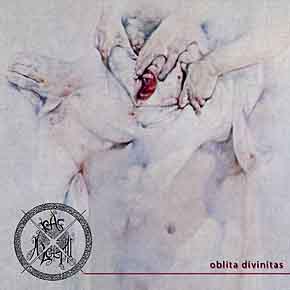
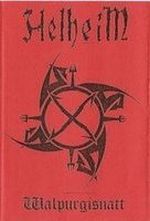 Ghoulish, ethereal and enwrapped in a magnetic tape production reeking of ancient tombs and broken 4-trackers, Helheim’s vision of industrial black metal is far more elemental than the connotations of that description during the last decade. As with the primitivist throbbing drum machines of Mysticum and the ambient blankets of Sort Vokter, the aim is ritual-hypnotic music which does not try to spice up black metal in order to make it more comforting or exciting; instead, it challenges one’s concentration by looping, returning and rewiring little fragments and pieces of riff in powerful early Norwegian black metal language, conducted by the raging screams of the now-deceased vocalist Jon A. Bjerk. The svastika simulacrum depicted on the cover highlights the natural difference with the smoother approach of the other Helheim of the same era, famed mostly for the vagrant mythological epics of “Jormundgand” – this Helheim rather spits in the face of the observed tradition in order to bring forth the subconscious terror of life and death that has been embedded in the mythos of all ancient cultures and bring across a pertinent message to the civilization (macrocosmically) and the black metal of our time (microcosmically). –Devamitra
Ghoulish, ethereal and enwrapped in a magnetic tape production reeking of ancient tombs and broken 4-trackers, Helheim’s vision of industrial black metal is far more elemental than the connotations of that description during the last decade. As with the primitivist throbbing drum machines of Mysticum and the ambient blankets of Sort Vokter, the aim is ritual-hypnotic music which does not try to spice up black metal in order to make it more comforting or exciting; instead, it challenges one’s concentration by looping, returning and rewiring little fragments and pieces of riff in powerful early Norwegian black metal language, conducted by the raging screams of the now-deceased vocalist Jon A. Bjerk. The svastika simulacrum depicted on the cover highlights the natural difference with the smoother approach of the other Helheim of the same era, famed mostly for the vagrant mythological epics of “Jormundgand” – this Helheim rather spits in the face of the observed tradition in order to bring forth the subconscious terror of life and death that has been embedded in the mythos of all ancient cultures and bring across a pertinent message to the civilization (macrocosmically) and the black metal of our time (microcosmically). –Devamitra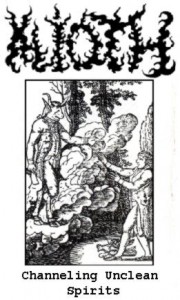 Remember how disappointed you were the last time you heard a new Varathron or Rotting Christ album? If the same lack of consistency and effort permeates other areas of Greek society, them having descended from the mythic glory of Athene into debts and poverty needs hardly the prophetic eye of Cassandra to fully explain. As in Neil Gaiman’s fantasy novel “American Gods” the lost European deities are found prowling the Wisconsin backwoods, Chicago based Alioth’s mystical and sensual tribute to Hellenic black metal ca. 1993 is admirably not only a continuation of the electric technoid dynamo drumbeat and an application of the palm muted speed and doom riffs in esoteric underground context; it’s also a highly logically strung sequence of moods as if the physical organization of pain and pleasure in a Dionysian ritual theatre, succumbing with the heavy held back moments of “The Channeling” and “Apocryphal Dimensions” and rising through the interludial “Invocation” and “Invocation II” to softly expire orgasmic relaxation. So much could be created out of this basic concept that it’s a pity the full-length album has remained cloaked in the depths of the primal sea, while Wargoat Obscurum iterates far less subtle (and far less interesting) metal with Cult of Daath. –Devamitra
Remember how disappointed you were the last time you heard a new Varathron or Rotting Christ album? If the same lack of consistency and effort permeates other areas of Greek society, them having descended from the mythic glory of Athene into debts and poverty needs hardly the prophetic eye of Cassandra to fully explain. As in Neil Gaiman’s fantasy novel “American Gods” the lost European deities are found prowling the Wisconsin backwoods, Chicago based Alioth’s mystical and sensual tribute to Hellenic black metal ca. 1993 is admirably not only a continuation of the electric technoid dynamo drumbeat and an application of the palm muted speed and doom riffs in esoteric underground context; it’s also a highly logically strung sequence of moods as if the physical organization of pain and pleasure in a Dionysian ritual theatre, succumbing with the heavy held back moments of “The Channeling” and “Apocryphal Dimensions” and rising through the interludial “Invocation” and “Invocation II” to softly expire orgasmic relaxation. So much could be created out of this basic concept that it’s a pity the full-length album has remained cloaked in the depths of the primal sea, while Wargoat Obscurum iterates far less subtle (and far less interesting) metal with Cult of Daath. –Devamitra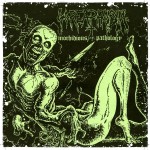 Goreaphobia’s debut album wouldn’t have been quite so eagerly anticipated without a strong back catalogue of minor releases such as the ‘Morbidious Pathology’ demo, which provides an unexpected listening experience if Mortal Repulsion is the only recording you’ve heard from the band. Where the full-length communicates visions from the abyss through the blank eyes of an old mystic locked in a lucid dreaming state, this demo is full of enough youthful energy to express the paranoia of a thousand souls trapped within the claustrophobic confines of their own mortality. Variations in riffs reflect these tightly packed structures, seeming to progress with not so much a linear logic than the re-arranging of parts of the whole, like limbs being removed from a body and sewn on to somewhere else entirely until the true grotesqueness of humanity is revealed. As with Mortal Repulsion, despite the physical connections to Incantation, there is a stronger similarity to the craftsmanship of Immolation and albums that would come in later years, such as the complex and disjointed but melodically evocative Here in After. The lead guitar work, though highly restrained, possesses a sense of neoclassical refinement that bridges some short-burst riffage with eloquent but totally disturbing solos. This demo shows the beginnings of an all too rare experiment in Death Metal where you can observe the maturation of a consistant idea as it goes through the turmoil of a tortured, temporal existence. –ObscuraHessian
Goreaphobia’s debut album wouldn’t have been quite so eagerly anticipated without a strong back catalogue of minor releases such as the ‘Morbidious Pathology’ demo, which provides an unexpected listening experience if Mortal Repulsion is the only recording you’ve heard from the band. Where the full-length communicates visions from the abyss through the blank eyes of an old mystic locked in a lucid dreaming state, this demo is full of enough youthful energy to express the paranoia of a thousand souls trapped within the claustrophobic confines of their own mortality. Variations in riffs reflect these tightly packed structures, seeming to progress with not so much a linear logic than the re-arranging of parts of the whole, like limbs being removed from a body and sewn on to somewhere else entirely until the true grotesqueness of humanity is revealed. As with Mortal Repulsion, despite the physical connections to Incantation, there is a stronger similarity to the craftsmanship of Immolation and albums that would come in later years, such as the complex and disjointed but melodically evocative Here in After. The lead guitar work, though highly restrained, possesses a sense of neoclassical refinement that bridges some short-burst riffage with eloquent but totally disturbing solos. This demo shows the beginnings of an all too rare experiment in Death Metal where you can observe the maturation of a consistant idea as it goes through the turmoil of a tortured, temporal existence. –ObscuraHessian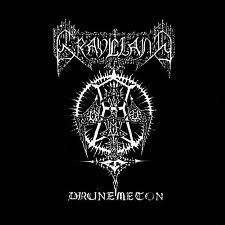 It’s not difficult to understand the distaste that Darken has for the recordings commited to tape during Graveland’s infancy in the light of his recent catalogue of pristine, epic and Atlantaean creations. Some distance away from the expansive scenes of battlefields and expressions of Romantic nationalism, this ancient offering from the living master of Pagan Black Metal is totally shrouded in a necrotic production, like ghostly shadows moving through oaken forests, casting a spell within more cloistered and Druidic surroundings than the output of Graveland from the past 15 years. Alongside the visions that created the force of Scandinavian Black Metal in the early 90′s, this demo represents the reclusive and misanthropic esotericism of that era, especially the primality of the lowest fidelity cults, Beherit and Ildjarn. Sounding like the work of a punk ostracised by that increasingly over-socialised group for being too idealistic and inhuman, Darken conjures a lurid interpretation of hypnotic Bathorean riffing that develops through the echoing of majestic, synthesised voices that open this recording as though a prologue to ‘The Celtic Winter’. The experimentation with primitivism in ‘Drunemeton’ is so deconstructionist that the guitar technique becomes fragmented completely and subordinated to reveal gloomy ambient moods that amplify the silence of a forest at night before the dawn of battle. There’s a similarity to the Beherit song ‘Nuclear Girl’ in how the guitar is used more like a sample, reverberating it’s texture through the keyboards to emphasise a cloistered sensation, accompanied by monastic chants at other times. Culminating in the ambient classic, ‘The Forest of Nemeton’, this demo is the successful beginnings of Graveland’s exploration into unconventional and nihilistic territory beneath the folky phrasing of guitar-led melodic work, which would shape the dynamic of his entire discography to follow. –ObscuraHessian
It’s not difficult to understand the distaste that Darken has for the recordings commited to tape during Graveland’s infancy in the light of his recent catalogue of pristine, epic and Atlantaean creations. Some distance away from the expansive scenes of battlefields and expressions of Romantic nationalism, this ancient offering from the living master of Pagan Black Metal is totally shrouded in a necrotic production, like ghostly shadows moving through oaken forests, casting a spell within more cloistered and Druidic surroundings than the output of Graveland from the past 15 years. Alongside the visions that created the force of Scandinavian Black Metal in the early 90′s, this demo represents the reclusive and misanthropic esotericism of that era, especially the primality of the lowest fidelity cults, Beherit and Ildjarn. Sounding like the work of a punk ostracised by that increasingly over-socialised group for being too idealistic and inhuman, Darken conjures a lurid interpretation of hypnotic Bathorean riffing that develops through the echoing of majestic, synthesised voices that open this recording as though a prologue to ‘The Celtic Winter’. The experimentation with primitivism in ‘Drunemeton’ is so deconstructionist that the guitar technique becomes fragmented completely and subordinated to reveal gloomy ambient moods that amplify the silence of a forest at night before the dawn of battle. There’s a similarity to the Beherit song ‘Nuclear Girl’ in how the guitar is used more like a sample, reverberating it’s texture through the keyboards to emphasise a cloistered sensation, accompanied by monastic chants at other times. Culminating in the ambient classic, ‘The Forest of Nemeton’, this demo is the successful beginnings of Graveland’s exploration into unconventional and nihilistic territory beneath the folky phrasing of guitar-led melodic work, which would shape the dynamic of his entire discography to follow. –ObscuraHessian Fifteen years ago, we were too proud and lofty to listen to it, our sensory devices soothed and inflamed by Panzerfaust, Battles in the North and Høstmørke, while the new generation of neo-progressive and mainstream black metal bands sought to enrapture even wider audiences with movie soundtrack influenced keyboards and angelic female voice conjured by fat-bottomed gothic tarts. For the atmospheric maniacs only, as it’s hard to argue for its musicality against the likes of Vikingligr Veldi; but the epic wanderlust and distorted pagan death ritual of this demo’s centerpiece, “Fimbulwinter”, unfolding like a flower at dawn or the psychedelic mandala of LSD invading brain receptors, is one of the pure innocent and mesmerizing gems of underground black metal in this sacred and forsaken era. The primal Isvind-esque melody dance like ripples of waves on a forest pond, the hissing tracker production complete with the macabre clack of a drum machine and the dampness of a Nordic bedroom cellar permeate the recording to such a thickness of adolescent black metal fury that it’s hardly palatable to generic audiences then and now. Barely a trace of the fast norsecore of the more familiar debut album Kill For Satan is noticeable here, the only similarity being the guitarist Draugluin’s technique of bricklike tremolo chord architecture where rhythm plays little importance. While primitive, this compositional method bears an intrinsic beauty which is worthy of recapitulation when the pure augustness of early Norwegian black metal has mostly become forgotten in favour of seemingly more rich and elaborate indie stylings. –Devamitra
Fifteen years ago, we were too proud and lofty to listen to it, our sensory devices soothed and inflamed by Panzerfaust, Battles in the North and Høstmørke, while the new generation of neo-progressive and mainstream black metal bands sought to enrapture even wider audiences with movie soundtrack influenced keyboards and angelic female voice conjured by fat-bottomed gothic tarts. For the atmospheric maniacs only, as it’s hard to argue for its musicality against the likes of Vikingligr Veldi; but the epic wanderlust and distorted pagan death ritual of this demo’s centerpiece, “Fimbulwinter”, unfolding like a flower at dawn or the psychedelic mandala of LSD invading brain receptors, is one of the pure innocent and mesmerizing gems of underground black metal in this sacred and forsaken era. The primal Isvind-esque melody dance like ripples of waves on a forest pond, the hissing tracker production complete with the macabre clack of a drum machine and the dampness of a Nordic bedroom cellar permeate the recording to such a thickness of adolescent black metal fury that it’s hardly palatable to generic audiences then and now. Barely a trace of the fast norsecore of the more familiar debut album Kill For Satan is noticeable here, the only similarity being the guitarist Draugluin’s technique of bricklike tremolo chord architecture where rhythm plays little importance. While primitive, this compositional method bears an intrinsic beauty which is worthy of recapitulation when the pure augustness of early Norwegian black metal has mostly become forgotten in favour of seemingly more rich and elaborate indie stylings. –Devamitra
 On first listen some would easily assume that this release were a mere product of nostalgia of underground metal of the 1980′s, at least indicated so by the production and indication that are present here. However this is death/speed/black metal firmly rooted in the underground
On first listen some would easily assume that this release were a mere product of nostalgia of underground metal of the 1980′s, at least indicated so by the production and indication that are present here. However this is death/speed/black metal firmly rooted in the underground 
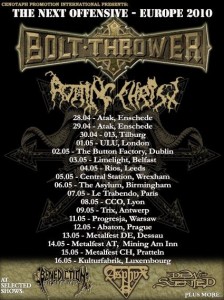 Returning from the brutality of a Bolt Thrower show to recollect the events that defined it brings to mind the task of Ernst Junger, depicting the graphic scenes of martial violence and destruction in his soldier’s memoirs, ‘Storm of Steel’. Not merely the sounds of war and chaos, but the philosophy of death is what one has to confront on such a stage, and this sums up the depth of the Bolt Thrower experience. The great elemental gods of Britannia fired the opening salvo of the evening, unleashing a torrential downpour on the troops to be in attendance once conscripted into the dismal but still functional ULU venue, around the University College London site and home of the un-elite Utilitarian philosophy. A single flash of lightning, probably striking the Cenotaph for the war dead a few minutes away in Whitehall, would indicate that this night belonged to only one elite group, and the slowly multiplying hordes as if signalled to the venue by this storm omen, proved that the headliners were in everybody’s iron sights.
Returning from the brutality of a Bolt Thrower show to recollect the events that defined it brings to mind the task of Ernst Junger, depicting the graphic scenes of martial violence and destruction in his soldier’s memoirs, ‘Storm of Steel’. Not merely the sounds of war and chaos, but the philosophy of death is what one has to confront on such a stage, and this sums up the depth of the Bolt Thrower experience. The great elemental gods of Britannia fired the opening salvo of the evening, unleashing a torrential downpour on the troops to be in attendance once conscripted into the dismal but still functional ULU venue, around the University College London site and home of the un-elite Utilitarian philosophy. A single flash of lightning, probably striking the Cenotaph for the war dead a few minutes away in Whitehall, would indicate that this night belonged to only one elite group, and the slowly multiplying hordes as if signalled to the venue by this storm omen, proved that the headliners were in everybody’s iron sights. In the meantime, some fairly well-known bands would run through comparitively uninteresting sets in order to plug new albums or just an association with Bolt Thrower on this Next Offensive European tour. For the one unknown band, clearly grateful to the Coventry squadron for being able to provide opening infantry support, Ancient Ascendant took to the stage with some confidence and raged through their set infront of the minimal crowd at this time. The sound was not good and the technical setup of the venue’s sonic equipment would be a recurring issue throughout the night, usually leaving bands with an unbalanced sound. Even less impressive was Ancient Ascendant’s music, which was practically educated by the newer schools of Death Metal exclusively, sounding like a more frivolously melodic version of Bloodbath. A lot of generic rhythmic business with some predictably inserted flourishes of lead guitar lines and none of the compositional sense that at the very least ripping-off the old school Death Metal formula would have imbued the songs with by default. Even the next band, The Rotted’s only listenable song was from the older generic Gorerotted project, which is not much less moronic than The Rotted who are really damn retarded in this incarnation, with their stripped down songs consisting of one riff from a later Cryptopsy song played out as blasting Punk music. It’s also quite strange and not recommended to watch old, drugged up men performing breakdowns.
In the meantime, some fairly well-known bands would run through comparitively uninteresting sets in order to plug new albums or just an association with Bolt Thrower on this Next Offensive European tour. For the one unknown band, clearly grateful to the Coventry squadron for being able to provide opening infantry support, Ancient Ascendant took to the stage with some confidence and raged through their set infront of the minimal crowd at this time. The sound was not good and the technical setup of the venue’s sonic equipment would be a recurring issue throughout the night, usually leaving bands with an unbalanced sound. Even less impressive was Ancient Ascendant’s music, which was practically educated by the newer schools of Death Metal exclusively, sounding like a more frivolously melodic version of Bloodbath. A lot of generic rhythmic business with some predictably inserted flourishes of lead guitar lines and none of the compositional sense that at the very least ripping-off the old school Death Metal formula would have imbued the songs with by default. Even the next band, The Rotted’s only listenable song was from the older generic Gorerotted project, which is not much less moronic than The Rotted who are really damn retarded in this incarnation, with their stripped down songs consisting of one riff from a later Cryptopsy song played out as blasting Punk music. It’s also quite strange and not recommended to watch old, drugged up men performing breakdowns. Considered by many as nothing more than a brief distraction, this was soon forgotten as the once powerful entity of Promethean Greek Black Metal took to the stage and the floor swelled with eager hordes. For someone that reveres the older fraction of their catalogue as highly as the Nordic classics, the Rotting Christ set provided both frustrating disappointment but also possibly the biggest surprise of the evening (not the appearance of Diamanda Galas). The transition from ancient Heavy Metal-inflected compositions of blackened mysticism to a boring and cheap form of fast and extreme Rock music with pseudo-cultural embellishments that would make Vangelis either laugh hysterically or summon the wrath of Mars upon Sakis and company, was made quite some time ago when the band sold out to Century Media and although the recent jump to Season of Mist has only marginally improved the quality of their music, the bulk of their songs is blockheaded rhythmic work that wouldn’t sound out of place on a System of a Down joke and disembodied keyboards typical of mainstream Black Metal bands to accompany the minute flickerings of nostalgia that is the signature Rotting Christ melodic style, the same tactic used by fellow Greeks, Septicflesh. Within this disastrous but obviously crowd-pleasing selection of tracks was something quite unexpected given the current direction of the band and their most recent live performances. Almost as though the old spirit of Necromayhem broke free from his sealed confines, the band launched mercilessly into ‘Sign of Evil Existence’, flooding the crowd with a sea of beautiful, extended phrasal work, causing an absolute frenzy and evoking the first old school invocations of the night. Not content with such a brief introduction to arguably the pinnacle of their early discography, ‘Fgmenth, Thy Gift’ continued the magic of ‘Thy Mighty Contract’ with the folky but regal opening riff surging into those magestic, ascendant patterns of guitar. The higher register key of these older songs manipulated the flatness of the sound setup brilliantly, with every note perfectly audible and a memorable contender for song of the entire show.
Considered by many as nothing more than a brief distraction, this was soon forgotten as the once powerful entity of Promethean Greek Black Metal took to the stage and the floor swelled with eager hordes. For someone that reveres the older fraction of their catalogue as highly as the Nordic classics, the Rotting Christ set provided both frustrating disappointment but also possibly the biggest surprise of the evening (not the appearance of Diamanda Galas). The transition from ancient Heavy Metal-inflected compositions of blackened mysticism to a boring and cheap form of fast and extreme Rock music with pseudo-cultural embellishments that would make Vangelis either laugh hysterically or summon the wrath of Mars upon Sakis and company, was made quite some time ago when the band sold out to Century Media and although the recent jump to Season of Mist has only marginally improved the quality of their music, the bulk of their songs is blockheaded rhythmic work that wouldn’t sound out of place on a System of a Down joke and disembodied keyboards typical of mainstream Black Metal bands to accompany the minute flickerings of nostalgia that is the signature Rotting Christ melodic style, the same tactic used by fellow Greeks, Septicflesh. Within this disastrous but obviously crowd-pleasing selection of tracks was something quite unexpected given the current direction of the band and their most recent live performances. Almost as though the old spirit of Necromayhem broke free from his sealed confines, the band launched mercilessly into ‘Sign of Evil Existence’, flooding the crowd with a sea of beautiful, extended phrasal work, causing an absolute frenzy and evoking the first old school invocations of the night. Not content with such a brief introduction to arguably the pinnacle of their early discography, ‘Fgmenth, Thy Gift’ continued the magic of ‘Thy Mighty Contract’ with the folky but regal opening riff surging into those magestic, ascendant patterns of guitar. The higher register key of these older songs manipulated the flatness of the sound setup brilliantly, with every note perfectly audible and a memorable contender for song of the entire show. Benediction were next on stage, an aging group of Death Metal punks fronted by Dave Hunt of Anaal Nathrakh, Mistress and Never Mind the Buzzcocks fame, who nearly talks as much shit on stage as Barney Greenway, including an embarrassing appeasement of some girl’s sob story about a now deceased Benediction fan, thankfully met with a shout of ‘Only death is real’ from the front of the crowd. The set itself was a typically reliable collection of songs spanning most of their discography, better suiting the live environment than on CD, inducing as much violence from the crowd as their primitive, bouncy Death Metal can, like ‘Harmony Corruption’-era Napalm Death meeting ‘Tower of Spite’ by Cerebral Fix. It wasn’t much of a loss to have a guitar cut out during their stint, as the rest of the band seemed to push onwards, building up as much aggression as possible and justifying their placement on the bill, though it was huge relief to hear the end of Benediction at long last, for the lights to dim and the next offensive to commence proper.
Benediction were next on stage, an aging group of Death Metal punks fronted by Dave Hunt of Anaal Nathrakh, Mistress and Never Mind the Buzzcocks fame, who nearly talks as much shit on stage as Barney Greenway, including an embarrassing appeasement of some girl’s sob story about a now deceased Benediction fan, thankfully met with a shout of ‘Only death is real’ from the front of the crowd. The set itself was a typically reliable collection of songs spanning most of their discography, better suiting the live environment than on CD, inducing as much violence from the crowd as their primitive, bouncy Death Metal can, like ‘Harmony Corruption’-era Napalm Death meeting ‘Tower of Spite’ by Cerebral Fix. It wasn’t much of a loss to have a guitar cut out during their stint, as the rest of the band seemed to push onwards, building up as much aggression as possible and justifying their placement on the bill, though it was huge relief to hear the end of Benediction at long last, for the lights to dim and the next offensive to commence proper.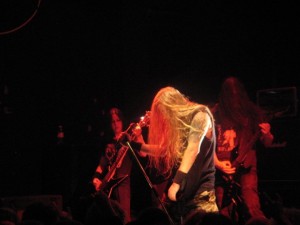 Bolt Thrower commanded the crowd, Karl Willets looked like a war-torn veteran but still yet to be tamed as the ferocity of his vocals didn’t let up for an instant. Jo-Anne Bench is undoubtedly the most menacing female presence in the entire Metal scene, and the poorly balanced sound worked well to render the songs with more bassy fury than can be heard on record. The subtle rhythmic variations of Baz’s guitars on the other hand were not as discernable, but for a seemingly undiscerning crowd, this did nothing to quell the primal violence that tore bones asunder in a ritual of combat replication. The signature riffs were also fairly muted but managed to somehow shine through like the sun between Afghan mountain peaks, and as the band returned for an encore, the perfect choice of songs scorched the stage like a vast napalm attack, with the ominous theme of ‘War’ transforming into ‘Remembrance’ as though the sorrows of Arjuna had been cast aside as he takes to the empty plains of Kurukshetra, seeing the world as it is.
Bolt Thrower commanded the crowd, Karl Willets looked like a war-torn veteran but still yet to be tamed as the ferocity of his vocals didn’t let up for an instant. Jo-Anne Bench is undoubtedly the most menacing female presence in the entire Metal scene, and the poorly balanced sound worked well to render the songs with more bassy fury than can be heard on record. The subtle rhythmic variations of Baz’s guitars on the other hand were not as discernable, but for a seemingly undiscerning crowd, this did nothing to quell the primal violence that tore bones asunder in a ritual of combat replication. The signature riffs were also fairly muted but managed to somehow shine through like the sun between Afghan mountain peaks, and as the band returned for an encore, the perfect choice of songs scorched the stage like a vast napalm attack, with the ominous theme of ‘War’ transforming into ‘Remembrance’ as though the sorrows of Arjuna had been cast aside as he takes to the empty plains of Kurukshetra, seeing the world as it is.
 Showing a strong advancement in technique and an evolution towards a darker style that would be the staple of records to come by the band, Slayer throw off the camp shackles of their excellent first album, and give a more progressive approach to songcraft yet give more emphasis on repetition within individual riffs. The violent droning guitar timbre of Discharge makes itself ever more present whilst the musical language of Judas Priest and Angel Witch works itself within those patterns. The dissonant twin soloing of King and Hanneman is more suitable to this new direction also, whilst Lombardo’s aggressive battery finds more cohesion in using less variation and being more of an ambient backdrop than before, with Araya’s unmistakable rasp encoding itself sadistically within the depths. A bleak affair that summed up the apocalyptic meanderings of the speed metal movement and the embryonic beginnings of the death metal that was yet to manifest. -Pearson
Showing a strong advancement in technique and an evolution towards a darker style that would be the staple of records to come by the band, Slayer throw off the camp shackles of their excellent first album, and give a more progressive approach to songcraft yet give more emphasis on repetition within individual riffs. The violent droning guitar timbre of Discharge makes itself ever more present whilst the musical language of Judas Priest and Angel Witch works itself within those patterns. The dissonant twin soloing of King and Hanneman is more suitable to this new direction also, whilst Lombardo’s aggressive battery finds more cohesion in using less variation and being more of an ambient backdrop than before, with Araya’s unmistakable rasp encoding itself sadistically within the depths. A bleak affair that summed up the apocalyptic meanderings of the speed metal movement and the embryonic beginnings of the death metal that was yet to manifest. -Pearson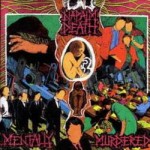 This work is like a convergence of Napalm Death and Carcass, having left From Enslavement to Obliteration and Reek or Putrefaction behind in order to expand on their styles, towards Harmony Corruption and Symphonies of Sickness respectively. By Napalm’s standards, at this point in their discography, these songs are quite lengthy and structured with an attention to detail that recaptures the subtle shifts in mechanical motion of the earliest side to Scum. This technique is re-invigorated by the cleaner production, relegating the extremity of fuzzy bass for the sake of a twin-guitar assault that creates an hypnotic and delusional sensation, and shows the input of Jesse Pintado who would go on to record another highly influential work of Grindcore – Terrorizer’s World Downfall. Composition is practically freed at very the earliest moments of songs onwards, unlike previous Napalm Death albums where these parts were used to establish exactly which single riff will become immersed in a barely discernable anarchic explosion for the rest of the 30 seconds of music. Instead, it’s given a more Death Metal treatment, e.g. in ‘The Missing Link’, the opening riff seems to degrade over time into smaller grinding patterns until the fragments are juggled like sacks of meat by morbid Death Metal riffs. This is where some of the tremelo melodies that would tear through the rotten wall of sound of Carcass finds its place, accompanied by the mocking lead guitars of Bill Steer. The human tornado, Mick Harris is even more precise than his previous effort, but doesn’t lose any of his epithet’s justification. Lee Dorrian’s vocals become more guttural and undecypherable, conceding to the futility of mainstream political discussion. The seeds of an approach closer in line with the burgeoning interest in Death Metal were sown here, simultaneously taking Grindcore one step further away from reaching the dead-end of short and simplistic outbursts of truncated riffs and hollow statements. -ObscuraHessian
This work is like a convergence of Napalm Death and Carcass, having left From Enslavement to Obliteration and Reek or Putrefaction behind in order to expand on their styles, towards Harmony Corruption and Symphonies of Sickness respectively. By Napalm’s standards, at this point in their discography, these songs are quite lengthy and structured with an attention to detail that recaptures the subtle shifts in mechanical motion of the earliest side to Scum. This technique is re-invigorated by the cleaner production, relegating the extremity of fuzzy bass for the sake of a twin-guitar assault that creates an hypnotic and delusional sensation, and shows the input of Jesse Pintado who would go on to record another highly influential work of Grindcore – Terrorizer’s World Downfall. Composition is practically freed at very the earliest moments of songs onwards, unlike previous Napalm Death albums where these parts were used to establish exactly which single riff will become immersed in a barely discernable anarchic explosion for the rest of the 30 seconds of music. Instead, it’s given a more Death Metal treatment, e.g. in ‘The Missing Link’, the opening riff seems to degrade over time into smaller grinding patterns until the fragments are juggled like sacks of meat by morbid Death Metal riffs. This is where some of the tremelo melodies that would tear through the rotten wall of sound of Carcass finds its place, accompanied by the mocking lead guitars of Bill Steer. The human tornado, Mick Harris is even more precise than his previous effort, but doesn’t lose any of his epithet’s justification. Lee Dorrian’s vocals become more guttural and undecypherable, conceding to the futility of mainstream political discussion. The seeds of an approach closer in line with the burgeoning interest in Death Metal were sown here, simultaneously taking Grindcore one step further away from reaching the dead-end of short and simplistic outbursts of truncated riffs and hollow statements. -ObscuraHessian Warm, playful and overflowing with the abundance of inspiration in the rediscovery of ancient shamanic techniques of mystical metal creation, the Greek pioneers of Rotting Christ forsook the aggravated modern noise of grindcore in time to ride the wave of blackness that usurped the European metal underground. Remnants and glimpses of 80’s fast modern metal (Slayer) give way to an astral, luminous intensity of synthesizers and slowly picked melodies that suspend the themes for a moment to enable the mind to stop wandering and relish the unholy moment of concentration, in a yogic gesture of blackness. Few have ever used the crushing sonic world of black and death metal to so fully immerse in ethereal ritual, and such rare examples as Drawing Down the Moon preserve plenty of subtle reminders to this widely heard classic of European black metal. As their chaotic exhortations in countless zines of the period conclude, Rotting Christ’s hybrid of gothic and black metal aimed for an architecture of the infinite, regal sunsets of lost kingdoms whose landscapes are not for the eyes of mortals, except in dreams and in death. As “Forest of N’Gai” aptly proves, black metal was at its height when not contorted to fit the schemes of a political ideology or an orthodox Satanist movement, but like the great works of literature a realm of fantasy of its own whose symbols are rooted in our deepest unconscious fears and desires. This sub-space can then be used by the analytical mind to figure the patterns of generation for a multitude of creative, even lunatic, concepts. -Devamitra
Warm, playful and overflowing with the abundance of inspiration in the rediscovery of ancient shamanic techniques of mystical metal creation, the Greek pioneers of Rotting Christ forsook the aggravated modern noise of grindcore in time to ride the wave of blackness that usurped the European metal underground. Remnants and glimpses of 80’s fast modern metal (Slayer) give way to an astral, luminous intensity of synthesizers and slowly picked melodies that suspend the themes for a moment to enable the mind to stop wandering and relish the unholy moment of concentration, in a yogic gesture of blackness. Few have ever used the crushing sonic world of black and death metal to so fully immerse in ethereal ritual, and such rare examples as Drawing Down the Moon preserve plenty of subtle reminders to this widely heard classic of European black metal. As their chaotic exhortations in countless zines of the period conclude, Rotting Christ’s hybrid of gothic and black metal aimed for an architecture of the infinite, regal sunsets of lost kingdoms whose landscapes are not for the eyes of mortals, except in dreams and in death. As “Forest of N’Gai” aptly proves, black metal was at its height when not contorted to fit the schemes of a political ideology or an orthodox Satanist movement, but like the great works of literature a realm of fantasy of its own whose symbols are rooted in our deepest unconscious fears and desires. This sub-space can then be used by the analytical mind to figure the patterns of generation for a multitude of creative, even lunatic, concepts. -Devamitra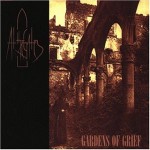 The original Gothenburg gloomy melody cult made one of their strongest statements on this early EP, pressed from demo to vinyl on the first year of the band’s existence. Fresh from life disrespecting bands such as Infestation and Grotesque, these Swedes nail the most desperate guitar harmonies since Candlemass, but infect them with the viral sensibility of a flux of death current. As if plugging the Sunlight Studios into your brains in direct interface, Svensson’s tremolos rip and rend mercilessly apart the soul of the beast that dared expose its true feelings of living in a world of hypocrisy and uncertainty. The band has preserved the most fragile moment of the Swedish death metal underground, the precarious balance between the catatonic psychosis of headbanging under alcoholic influence and the deep, burning, thoughtful soul of an encrypted Romantic in a world of pain and disguised memories. It all takes such tangible form in Tomas Lindberg’s cracking, maddened scream: “I am at the gates – Lord of Chaos – Let me sleep”. The fear and anger of At the Gates’ most revered albums will always remain something that divides audiences according to their response to such emotional cues, but “Gardens of Grief” is the un-terrorized, exuberant sound of youth that realizes the presence of death and dives into it headlong, appropriate to the Per Ohlin dedication in the liner notes. -Devamitra
The original Gothenburg gloomy melody cult made one of their strongest statements on this early EP, pressed from demo to vinyl on the first year of the band’s existence. Fresh from life disrespecting bands such as Infestation and Grotesque, these Swedes nail the most desperate guitar harmonies since Candlemass, but infect them with the viral sensibility of a flux of death current. As if plugging the Sunlight Studios into your brains in direct interface, Svensson’s tremolos rip and rend mercilessly apart the soul of the beast that dared expose its true feelings of living in a world of hypocrisy and uncertainty. The band has preserved the most fragile moment of the Swedish death metal underground, the precarious balance between the catatonic psychosis of headbanging under alcoholic influence and the deep, burning, thoughtful soul of an encrypted Romantic in a world of pain and disguised memories. It all takes such tangible form in Tomas Lindberg’s cracking, maddened scream: “I am at the gates – Lord of Chaos – Let me sleep”. The fear and anger of At the Gates’ most revered albums will always remain something that divides audiences according to their response to such emotional cues, but “Gardens of Grief” is the un-terrorized, exuberant sound of youth that realizes the presence of death and dives into it headlong, appropriate to the Per Ohlin dedication in the liner notes. -Devamitra An all too brief EP from Finnish gloomophiliacs Wings, as ephemeral as the tortured existence that is enshrouded in these twisted sounds of darkness-raped melody. Almost like the missing tracks from Cartilage’s cult classic ‘The Fragile Concept of Affection’, this continuation goes further to explore the sombre moods of songs like ‘Why Do I Watch The Dawn?’, in their Replicant-like reflections upon the transience of a human existence placed between the crushing, vice-grip of nothingness. Wings don’t peturb the balance of pace of slower, more expansive lakes of hypnotic melody that made up Cartilage’s contribution to their split with Altar, but there is greater focus on creating a doomier atmosphere, leaving no space for the grinding riffs of the past incarnation – a technique that parrelleled the Swedish Unleashed on their first album. Instead, an older treatment is given to the bouncier riffs, which could be heard as Punkier passages, but as this EP comes together as a whole to reveal, these bridge the narrative that seems to span across both songs with a mid-pace tempo in which the drawn out melodies pass through towards an expressive, quite neoclassical riff of totality – encompassing all the hopes that are weighed down by all the sorrows in the journey towards death. This poem in two parts is a valuable recording of Death Metal history, as a valid direction for these Finnish musicians to have taken following the demise of Cartilage, with all their weird melodic knowledge as baggage. -ObscuraHessian
An all too brief EP from Finnish gloomophiliacs Wings, as ephemeral as the tortured existence that is enshrouded in these twisted sounds of darkness-raped melody. Almost like the missing tracks from Cartilage’s cult classic ‘The Fragile Concept of Affection’, this continuation goes further to explore the sombre moods of songs like ‘Why Do I Watch The Dawn?’, in their Replicant-like reflections upon the transience of a human existence placed between the crushing, vice-grip of nothingness. Wings don’t peturb the balance of pace of slower, more expansive lakes of hypnotic melody that made up Cartilage’s contribution to their split with Altar, but there is greater focus on creating a doomier atmosphere, leaving no space for the grinding riffs of the past incarnation – a technique that parrelleled the Swedish Unleashed on their first album. Instead, an older treatment is given to the bouncier riffs, which could be heard as Punkier passages, but as this EP comes together as a whole to reveal, these bridge the narrative that seems to span across both songs with a mid-pace tempo in which the drawn out melodies pass through towards an expressive, quite neoclassical riff of totality – encompassing all the hopes that are weighed down by all the sorrows in the journey towards death. This poem in two parts is a valuable recording of Death Metal history, as a valid direction for these Finnish musicians to have taken following the demise of Cartilage, with all their weird melodic knowledge as baggage. -ObscuraHessian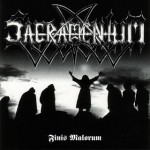 A true gem, Sacramentum’s first EP showcases a style that is melodic and emotive in a manner not unlike countrymen Dissection and Unanimated. Epic, catchy and well crafted compositions are multi-layered not unlike Emperor minus keyboards, the rush of guitar notes being vibrant and lively, with little emphasis towards a rhythmic expectation, as one would expect with most heavy metal and hard rock music. Simultaneously moody yet without being whiny, this early release by Sacramentum showcases a band who are able to master quality control and bring the best out of all the elements that define their music. Alongside At The Gates, artistically the finest Swedish metal act of the 1990′s. -Pearson
A true gem, Sacramentum’s first EP showcases a style that is melodic and emotive in a manner not unlike countrymen Dissection and Unanimated. Epic, catchy and well crafted compositions are multi-layered not unlike Emperor minus keyboards, the rush of guitar notes being vibrant and lively, with little emphasis towards a rhythmic expectation, as one would expect with most heavy metal and hard rock music. Simultaneously moody yet without being whiny, this early release by Sacramentum showcases a band who are able to master quality control and bring the best out of all the elements that define their music. Alongside At The Gates, artistically the finest Swedish metal act of the 1990′s. -Pearson Fast, raging black metal with the fury of early Deicide and the sharp harmonizing typical of Mayhem and Immortal’s ‘Pure Holocaust’ come head to head, in the guise of technically precise, abrupt songs. Shouty hardcore vocals, warm synth overlaps, a near constant blastbeat and anti-humanist lyrical concepts indicate a desire by known Norwegian musicians to advance the aggression of the black metal style and shift it’s idealogical focus away from romantic nostalgia. This brief E.P. lacks the spark of Norway’s foundational acts, but remains an influential statement of the subgenre. -Pearson
Fast, raging black metal with the fury of early Deicide and the sharp harmonizing typical of Mayhem and Immortal’s ‘Pure Holocaust’ come head to head, in the guise of technically precise, abrupt songs. Shouty hardcore vocals, warm synth overlaps, a near constant blastbeat and anti-humanist lyrical concepts indicate a desire by known Norwegian musicians to advance the aggression of the black metal style and shift it’s idealogical focus away from romantic nostalgia. This brief E.P. lacks the spark of Norway’s foundational acts, but remains an influential statement of the subgenre. -Pearson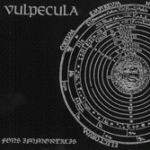 Who would have expected Chuck Keller to open the gates to very Orion itself after the folding of the aggressor squad par excellence Order from Chaos? As if a continuation of the promise of the astrological and alchemistic symbolism of the former bands’ lyrics, Vulpecula slows it down and strums soothing, yet vigorous melodies while the vocals multiple into wraith-like dimensions of rhythmic rasps and Keller’s leads occasionally burst into the aggressive, spasmous flight of an eagle amidst a thunderstorm. “Phoenix of the Creation” delves into exercises in authentic space synth, while “The First Point of Aries” harkens to the mid-paced woodland meditations that the Norwegians used to record at Grieghallen. Occasionally slightly hindered by the band’s eagerness to cram all the influences from Schulze to black metal into one short EP, the mere richness of it invites the ears to take their pleasure at will from the Babylonian garden of ponderous and prestigious movements that are achingly attractive and acceptable in their innocent refusal to complicate things with dissonance. Credit also goes for the lead guitar efforts of Keller on their traditional melodious injection which easily avoids the neutrality of more pop oriented bands trying to do the same. Almost like envisioning a “new age” approach to the genre, Vulpecula is an alien saucer amidst the orbit bound technologies of “progressive” death metal. -Devamitra
Who would have expected Chuck Keller to open the gates to very Orion itself after the folding of the aggressor squad par excellence Order from Chaos? As if a continuation of the promise of the astrological and alchemistic symbolism of the former bands’ lyrics, Vulpecula slows it down and strums soothing, yet vigorous melodies while the vocals multiple into wraith-like dimensions of rhythmic rasps and Keller’s leads occasionally burst into the aggressive, spasmous flight of an eagle amidst a thunderstorm. “Phoenix of the Creation” delves into exercises in authentic space synth, while “The First Point of Aries” harkens to the mid-paced woodland meditations that the Norwegians used to record at Grieghallen. Occasionally slightly hindered by the band’s eagerness to cram all the influences from Schulze to black metal into one short EP, the mere richness of it invites the ears to take their pleasure at will from the Babylonian garden of ponderous and prestigious movements that are achingly attractive and acceptable in their innocent refusal to complicate things with dissonance. Credit also goes for the lead guitar efforts of Keller on their traditional melodious injection which easily avoids the neutrality of more pop oriented bands trying to do the same. Almost like envisioning a “new age” approach to the genre, Vulpecula is an alien saucer amidst the orbit bound technologies of “progressive” death metal. -Devamitra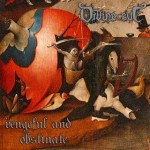 The first new release that’s being reviewed for 2010 and it’s already giving distinct impressions of the kind of quality that made 1993′s ‘As the Angels Weep’ a genuinely classic EP. Divine Eve keeps the form of this new material far simpler, stripping away the Death Metal-infected sludginess for a more rudimentary homage to early brutal music like Celtic Frost. ‘Vengeful and Obstinate’ makes its own unique statement by honing in on the nihilistic and warlike spirit of the Swiss legend’s To Mega Therion magnum opus, even invoking the same battle-horns on ‘Ravages of Heathen Men’ that bring focus to the beauty of conflict and strife in a meaningless universe. The varied tempo of grinding riffs set to a dirty bass guitar adds to the atmosphere of struggle as an outlet for this primitive, instinctual response to the world. ‘Whispers of Fire’ being the exception on this EP for the constantly up-tempo pace, it’s a pleasure to hear such slow and sludgy music churning visions of the darker universe beyond our lives of comfort and languish. The final and most devastating touch of ‘Vengeful and Obstinate’ is how Divine Eve makes extensive use of the piercing tone that Xan’s grating guitar setup produces, highlighting the spiral passage of powerchords by revealing their hidden, melodic architecture, ingenuiously managing to explain and enhance this rugged approach of legendary lineage. It’s about time the band produced a full-length and they’ve proved that they possess more than enough knowledge of unholy riffcraft to do so. -ObscuraHessian
The first new release that’s being reviewed for 2010 and it’s already giving distinct impressions of the kind of quality that made 1993′s ‘As the Angels Weep’ a genuinely classic EP. Divine Eve keeps the form of this new material far simpler, stripping away the Death Metal-infected sludginess for a more rudimentary homage to early brutal music like Celtic Frost. ‘Vengeful and Obstinate’ makes its own unique statement by honing in on the nihilistic and warlike spirit of the Swiss legend’s To Mega Therion magnum opus, even invoking the same battle-horns on ‘Ravages of Heathen Men’ that bring focus to the beauty of conflict and strife in a meaningless universe. The varied tempo of grinding riffs set to a dirty bass guitar adds to the atmosphere of struggle as an outlet for this primitive, instinctual response to the world. ‘Whispers of Fire’ being the exception on this EP for the constantly up-tempo pace, it’s a pleasure to hear such slow and sludgy music churning visions of the darker universe beyond our lives of comfort and languish. The final and most devastating touch of ‘Vengeful and Obstinate’ is how Divine Eve makes extensive use of the piercing tone that Xan’s grating guitar setup produces, highlighting the spiral passage of powerchords by revealing their hidden, melodic architecture, ingenuiously managing to explain and enhance this rugged approach of legendary lineage. It’s about time the band produced a full-length and they’ve proved that they possess more than enough knowledge of unholy riffcraft to do so. -ObscuraHessian Coming from the anarcho-punk school of musical and ideological tradition, and finally releasing this, their debut full length in 1985, Amebix had already released a series of excellent EP’s in the early half of the decade. The unique character of their music was a sound that fused the violent hardcore punk of Discharge with the circulative, repetitious song structures that were a staple of post-punk acts such as Killing Joke and Public Image Ltd. Escaping the social-activist themes that were a staple of hardcore, and transcending the melancholia and fatalism that was a common theme of post-punk, Amebix took on board the musical apparatus of both substyles and turned towards a contemplative, naturalistic direction that subverted the generalisation of how we associate themes with forms. Inspiration comes additionally from the NWOBHM of early Motorhead and Judas Priest in the crunching, percussive guitar playing that made itself a staple of speed metal and subsequently death metal. Drums batter clearly as if to stadium anthems, and boom with an echo one would clearly associate with said decade. Droning riffs make an appearance and have a harmonic depth to them that evoke the archaic and the dystopian much like Burzum and Godflesh simultaneously would do in their most prominent work. Whereas the metal subgenres of the 1980′s slowly influenced one anothers musical language, Amebix single handedly introduced new themes and formats that would become the structural basis of future acts to come, and alongside their compilation album No Sanctuary, this important work deserves it’s applause.
Coming from the anarcho-punk school of musical and ideological tradition, and finally releasing this, their debut full length in 1985, Amebix had already released a series of excellent EP’s in the early half of the decade. The unique character of their music was a sound that fused the violent hardcore punk of Discharge with the circulative, repetitious song structures that were a staple of post-punk acts such as Killing Joke and Public Image Ltd. Escaping the social-activist themes that were a staple of hardcore, and transcending the melancholia and fatalism that was a common theme of post-punk, Amebix took on board the musical apparatus of both substyles and turned towards a contemplative, naturalistic direction that subverted the generalisation of how we associate themes with forms. Inspiration comes additionally from the NWOBHM of early Motorhead and Judas Priest in the crunching, percussive guitar playing that made itself a staple of speed metal and subsequently death metal. Drums batter clearly as if to stadium anthems, and boom with an echo one would clearly associate with said decade. Droning riffs make an appearance and have a harmonic depth to them that evoke the archaic and the dystopian much like Burzum and Godflesh simultaneously would do in their most prominent work. Whereas the metal subgenres of the 1980′s slowly influenced one anothers musical language, Amebix single handedly introduced new themes and formats that would become the structural basis of future acts to come, and alongside their compilation album No Sanctuary, this important work deserves it’s applause. Following up the band’s debut album Tol Cormpt Norz Norz Norz, Impaled Nazarene opened the silo once again to release their deadliest missile of truly
Following up the band’s debut album Tol Cormpt Norz Norz Norz, Impaled Nazarene opened the silo once again to release their deadliest missile of truly 